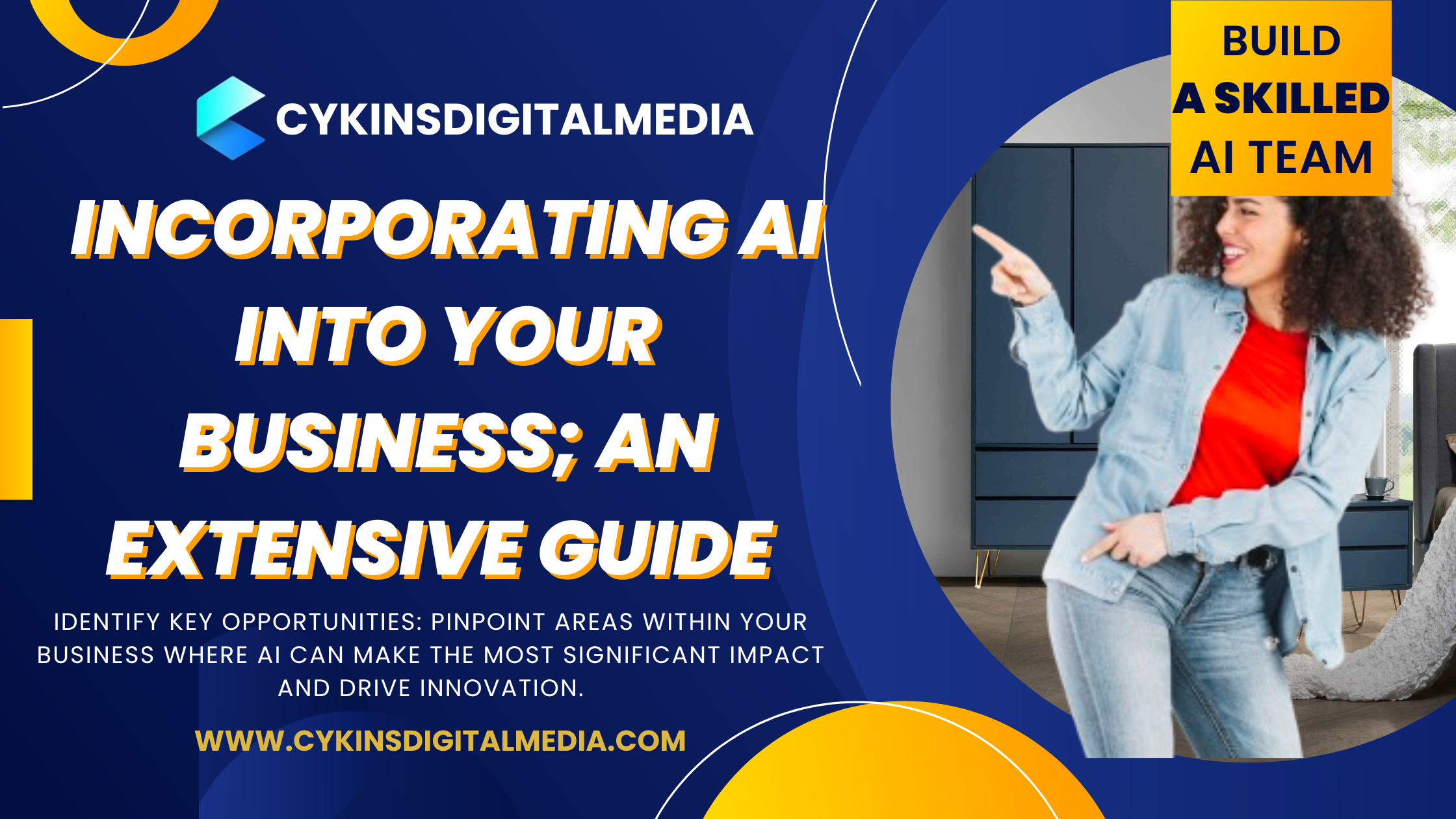
BY CYPRIANO AKINWUNMI
Incorporating AI into Your Business; An Extensive Guide
Introduction
The integration of Artificial Intelligence (AI) is rapidly reshaping the business environment. From automating tasks to providing data-driven insights, AI has emerged as an asset, for companies aiming to stay ahead of the competition. As a business owner embracing AI in your operations can open doors to opportunities for enhancing profitability.
With Cykinsdigitalmedia’s Incorporating AI into Your Business; An Extensive Guide, we will delve into the facets of embedding AI into your business discussing the advantages, obstacles, and recommended strategies for a successful integration.

Recognizing the Potential Impact of AI in Business

AI encompasses the creation of computer systems of executing tasks that traditionally demand intelligence, such, as learning, problem-solving, and decision-making. This groundbreaking technology holds the potential to transform your business practices in many ways;
Improved Efficiency: AI-driven systems can automate time-consuming tasks allowing your staff to concentrate on more strategic and innovative endeavours. For instance, AI chatbots can manage customer queries easing the burden on your support team and enhancing response times.
Augmented Decision Making: Through analyzing datasets, AI algorithms can pinpoint patterns, trends, and relationships that human observers might overlook. This data can be used to help make decisions based on information, improve procedures, and discover business prospects.
Enhanced Customer Satisfaction: AI can customize recommendations, adjust marketing strategies, and forecast consumer behavior resulting in increased customer contentment and loyalty.
Gaining a Competitive Edge Incorporating AI into your business: By incorporating AI into your company operations, you can simplify processes, obtain insights, and offer products or services that give you an advantage over competitors in the industry.
Evaluating Your Business Requirements

Before delving into implementing AI technology, it’s essential to evaluate your business needs and pinpoint areas where AI could have an impact. Begin by examining your existing procedures and tasks identifying areas of concern such as inefficiencies or data-heavy responsibilities that could benefit from the integration of AI.
Consider these queries;
- Where do your employees invest the time in time-consuming duties?
- Which decisions or forecasts could be enhanced through data-driven analysis?
- How can you improve customer satisfaction and personalization efforts?
- Which tasks or processes are prone to errors or delays that could be streamlined with AI assistance?
By outlining your objectives and aims for integrating AI technology, you can ensure that your investments align with your business priorities and yield outcomes.
Selecting the Right AI Solutions

Once you’ve pinpointed the areas where AI can enhance your business operations, the next step involves choosing the AI solutions. You have two choices; made tools or tailor-made AI applications.
Ready-Made AI Tools;
These are pre-designed AI solutions that can be seamlessly incorporated into your systems. Examples include chatbots, virtual assistants, and predictive analytics platforms. Made tools can deliver wins and are often more cost efficient but they may offer limited customization options.
Tailor Made AI Applications;
If your business has intricate needs, creating a built AI solution might be necessary. This approach allows for flexibility and customization to meet your requirements albeit it typically demands a greater investment of time and resources.
When assessing AI solutions take into account factors like;
- Compatibility, with your existing systems and data infrastructure.
- Scalability to support your business expansion.
- Ease of integration and user-friendliness for your staff.
- Continued support and upkeep from the provider.
Engaging with AI professionals or consulting firms can also assist you in navigating the selection process, and ensuring that the chosen solutions align, with your business objectives.
Getting Your Team Ready, for Incorporating AI

An integration of AI hinges on getting everyone on board and actively involved in the process. Concerns among employees about job security and the effects of AI on their roles need to be addressed, along with offering training and support. Here are some steps to adequately prepare your team for incorporating AI;
- Communicate the Advantages: Clearly outline the advantages of incorporating AI, such as increased efficiency, better decision-making, and enhanced customer interactions. Stress how AI can work alongside and empower your employees rather than replacing them.
- Provide Training and Education: Implement training programs to help your team grasp the potentials and limitations of AI well as how to effectively use the new tools and technologies. This will boost their confidence and involvement in the process of integrating AI.
- Promote an Innovative Culture: Cultivate a culture that values learning and experimentation. Encourage your team to explore AI tools to share their insights and collaborate on solutions.
- Define Clear Roles and Responsibilities: Lay out the roles and responsibilities of your team members in relation, to incorporating AI. Explain how their tasks and workflows will be influenced by it guiding how they can collaborate with AI systems.
- Consistently Seek Input: Make sure to ask your team for feedback during the process of integrating AI. This will help you spot and tackle any issues or worries ensuring a shift and getting the most out of AI technology.
Evaluating the Effectiveness of AI Integration

To make sure your efforts in integrating AI are producing the desired outcomes, it’s important to set up performance indicators (KPIs) and keep track of metrics. This will enable you to gauge how AI is impacting your business and make informed choices regarding investments.
Some factors to take into account include;
- Improvements in productivity and efficiency (such as time-saved tasks automated)
- Cost reductions (like labor expenses, and operational costs)
- Enhanced decision-making capabilities (for instance accuracy in predictions, and quality of insights)
- Boosted customer satisfaction levels (such as response times, and customer retention rates)
- Return on investment (ROI) for AI projects
- By monitoring these factors and adjusting your approach to AI when necessary, you can ensure that your integration efforts align with your business goals and deliver concrete advantages.
Addressing Common Obstacles
Bringing AI into your business comes with its share of challenges. Recognizing and dealing with these obstacles is vital, for an implementation.
- Data Accuracy and Accessibility: To train AI models effectively it’s crucial to maintain the accuracy, completeness, and accessibility of your data. Implement data governance and management practices.
- Finding and keeping employees with expertise in AI can pose a challenge. Consider training your staff or collaborating with AI professionals and consulting firms.
- With the increasing presence of AI, concerns about privacy, bias, and transparency are on the rise. Establish policies and guidelines to tackle these issues.
- Resistance to change can impede the adoption of AI in your organization. Effective communication, training programs, and change management strategies are key to overcoming this obstacle.
- Integrating AI solutions smoothly into your existing IT systems and business operations can be complicated. Thoughtful planning and a phased approach can help address these complexities.
By addressing these hurdles you can streamline the integration of AI for outcomes.
Looking ahead at trends in AI for businesses
As artificial intelligence continues to progress, businesses can anticipate developments, and trends in the field. Some important areas to keep an eye on include;
- Progress, in Natural Language Processing (NLP): Enhanced NLP capabilities will facilitate intuitive interactions between people and AI systems improving customer service and collaboration.
- Rising Use of Generative AI: Tools like ChatGPT and Midjourney will continue to transform content creation empowering businesses to efficiently produce high quality text, images and even code.
- Expansion of Explainable AI: With the increasing adoption of AI there will be a need for clarity and understanding of AI-driven decisions leading to the creation of transparent AI models.
- Integration of AI with Emerging Technologies: The combination of AI with technologies such, as the Internet of Things (IoT), blockchain, and edge computing will unlock possibilities and business prospects.
- Increased Emphasis on Ethical AI: Companies must prioritize practices in AI addressing issues related to bias, privacy, and the societal impact of AI-driven systems.
By keeping of these trends and developments, you can position your business to leverage the potential of AI and maintain a competitive advantage in the future.
In essence; Embracing Artificial Intelligence, for Business Development
Incorporating AI technology into your business can open up a plethora of opportunities revolutionizing your operations decision-making processes and customer interactions.
By comprehending the influence of AI, evaluating your business requirements, identifying solutions, and successfully integrating them, you can leverage the potential of AI to enhance your performance.
View AI as an asset and embark on a journey of learning and creativity. With this approach, your business can flourish in the era of intelligence.
Closing Reflections
Integrating AI into your business is no longer a notion but a crucial step to maintaining competitiveness in today’s environment. By embracing AI, you can access possibilities to streamline processes, improve customer satisfaction levels, and foster innovation within your company.
Remember that effective AI integration does not follow a one-size-fits-all model. It demands an in-depth understanding of your business requirements, a thought-out strategy, and a dedication to learning and adaptation. By staying abreast of the developments and trends in AI technology, you can position your business for success and expansion.
Check out the tools and platforms available
Additional Resources
AI Communities and Forums
Conferences and Workshops
FAQ
AI can drive business growth by boosting efficiency enhancing customer experiences and fostering innovation. Through automating tasks providing data-driven insights and personalizing interactions, AI opens up opportunities for revenue growth and cost savings. disciplines.
Some main challenges of integrating AI into your business include ensuring data quality and availability, recruiting and retaining talent, addressing regulatory issues, managing change effectively, and integrating with existing systems. Overcoming these hurdles demands a strategy, communication, as well as a dedication, to continuous learning and adaptation.
To integrate AI into your business start by evaluating your existing procedures and pinpointing areas where AI could make a difference. Look into tools and platforms. Think about collaborating with AI specialists or consulting companies to help you navigate the integration process.
Don’t forget to share the advantages of AI with your staff offer them the required training and assistance and encourage a culture of creativity and ongoing development.
Citations
1. 12 key benefits of AI for business – TechTarget
2. 5 ways AI can help your business do more – Sage Advice United Kingdom
3. How Artificial Intelligence Will Transform Businesses
4. The Integration of Artificial Intelligence (AI) Into Business Processes
5. How AI Is Used in Business – Investopedia
Articles and Journals
- MIT Sloan Management Review: Winning with AI
Online Courses
- Coursera: AI for Everyone
- Udemy: AI for Business Leaders
- Udacity: AI for Business Leaders Nanodegree
- University Of Helsinki: Elements of AI
